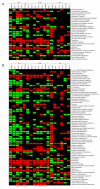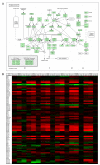Pathway-specific differences between tumor cell lines and normal and tumor tissue cells
- PMID: 17081305
- PMCID: PMC1635729
- DOI: 10.1186/1476-4598-5-55
Pathway-specific differences between tumor cell lines and normal and tumor tissue cells
Abstract
Background: Cell lines are used in experimental investigation of cancer but their capacity to represent tumor cells has yet to be quantified. The aim of the study was to identify significant alterations in pathway usage in cell lines in comparison with normal and tumor tissue.
Methods: This study utilized a pathway-specific enrichment analysis of publicly accessible microarray data and quantified the gene expression differences between cell lines, tumor, and normal tissue cells for six different tissue types. KEGG pathways that are significantly different between cell lines and tumors, cell lines and normal tissues and tumor and normal tissue were identified through enrichment tests on gene lists obtained using Significance Analysis of Microarrays (SAM).
Results: Cellular pathways that were significantly upregulated in cell lines compared to tumor cells and normal cells of the same tissue type included ATP synthesis, cell communication, cell cycle, oxidative phosphorylation, purine, pyrimidine and pyruvate metabolism, and proteasome. Results on metabolic pathways suggested an increase in the velocity nucleotide metabolism and RNA production. Pathways that were downregulated in cell lines compared to tumor and normal tissue included cell communication, cell adhesion molecules (CAMs), and ECM-receptor interaction. Only a fraction of the significantly altered genes in tumor-to-normal comparison had similar expressions in cancer cell lines and tumor cells. These genes were tissue-specific and were distributed sparsely among multiple pathways.
Conclusion: Significantly altered genes in tumors compared to normal tissue were largely tissue specific. Among these genes downregulation was a major trend. In contrast, cell lines contained large sets of significantly upregulated genes that were common to multiple tissue types. Pathway upregulation in cell lines was most pronounced over metabolic pathways including cell nucleotide metabolism and oxidative phosphorylation. Signaling pathways involved in adhesion and communication of cultured cancer cells were downregulated. The three way pathways comparison presented in this study brings light into the differences in the use of cellular pathways by tumor cells and cancer cell lines.
Figures




Similar articles
-
Pathway aberrations of murine melanoma cells observed in Paired-End diTag transcriptomes.BMC Cancer. 2007 Jun 26;7:109. doi: 10.1186/1471-2407-7-109. BMC Cancer. 2007. PMID: 17594473 Free PMC article.
-
Genome Wide Expression Profiling of Cancer Cell Lines Cultured in Microgravity Reveals Significant Dysregulation of Cell Cycle and MicroRNA Gene Networks.PLoS One. 2015 Aug 21;10(8):e0135958. doi: 10.1371/journal.pone.0135958. eCollection 2015. PLoS One. 2015. PMID: 26295583 Free PMC article.
-
cDNA microarray-based identification of genes and pathways associated with oxaliplatin resistance.Cancer Chemother Pharmacol. 2005 Jan;55(1):1-11. doi: 10.1007/s00280-004-0819-9. Epub 2004 Sep 16. Cancer Chemother Pharmacol. 2005. PMID: 15378272
-
Tissue microarray profiling of cancer specimens and cell lines: opportunities and limitations.Lab Invest. 2001 Oct;81(10):1331-8. doi: 10.1038/labinvest.3780347. Lab Invest. 2001. PMID: 11598146 Review.
-
Tissue microarrays for miniaturized high-throughput molecular profiling of tumors.Exp Hematol. 2002 Dec;30(12):1365-72. doi: 10.1016/s0301-472x(02)00965-7. Exp Hematol. 2002. PMID: 12482497 Review.
Cited by
-
A risk prediction model of gene signatures in ovarian cancer through bagging of GA-XGBoost models.J Adv Res. 2020 Nov 11;30:113-122. doi: 10.1016/j.jare.2020.11.006. eCollection 2021 May. J Adv Res. 2020. PMID: 34026291 Free PMC article.
-
Glutathione Reductase Expression and Its Prognostic Significance in Colon Cancer.Int J Mol Sci. 2024 Jan 16;25(2):1097. doi: 10.3390/ijms25021097. Int J Mol Sci. 2024. PMID: 38256170 Free PMC article.
-
NetCellMatch: Multiscale Network-Based Matching of Cancer Cell Lines to Patients Using Graphical Wavelets.Chem Biodivers. 2022 Dec;19(12):e202200746. doi: 10.1002/cbdv.202200746. Epub 2022 Nov 28. Chem Biodivers. 2022. PMID: 36279370 Free PMC article.
-
Characterization of a multidrug-resistant chronic myeloid leukemia cell line presenting multiple resistance mechanisms.Mol Cell Biochem. 2013 Nov;383(1-2):123-35. doi: 10.1007/s11010-013-1761-0. Epub 2013 Jul 23. Mol Cell Biochem. 2013. PMID: 23877223
-
A Medium-Throughput System for In Vitro Oxidative Stress Assessment in IPEC-J2 Cells.Int J Mol Sci. 2020 Oct 1;21(19):7263. doi: 10.3390/ijms21197263. Int J Mol Sci. 2020. PMID: 33019601 Free PMC article.
References
Publication types
MeSH terms
Grants and funding
LinkOut - more resources
Full Text Sources
Other Literature Sources

